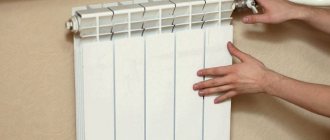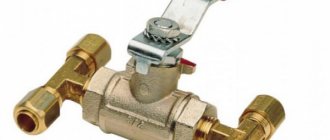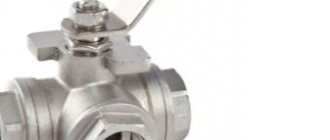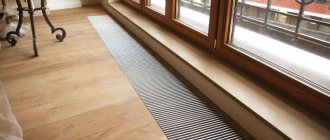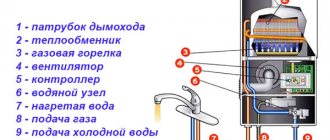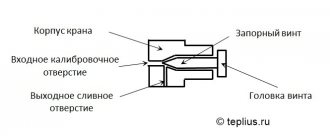Air valves shaped like radiator plugs
Lyrical digression. House owners and some “professionals” unknowingly call Mayevsky’s float valve an automated air vent, which is fundamentally wrong. In the 30s of the last century, the inventor Mayevsky proposed the design of a manual crane, but it has nothing to do with the “automatic machine”.
Where are the air release valves installed?
In any traditional heating system there are places where the installation of Mayevsky taps is mandatory. If we talk about air vents, then they must be installed on all batteries in order to bleed off the collected air. The exact location is in the plug in the upper corner, distant from the point where the supply line is connected to the device. An air bubble forms there.
If the boiler is equipped with a built-in Mayevsky tap, then it does not need to be installed on the supply side
The automated ventilation valve must be installed strictly vertically at the following points in the heating network:
- in the safety group of a boiler connected to a closed type system;
on two heated floor collectors;
In addition to the listed points, air vents are installed in problem areas of the heating network, where, due to difficult conditions for laying pipes, they form U-shaped loops turned upward. For example, the highway goes around the entrance opening or a flight of stairs at the top, and then goes down again. In similar compensators, air pockets appear with a 100% probability, so a Mayevsky crane is needed, preferably an automated one.
When a pipe or compensator is considered the highest point of the network, a valve is installed on it
Advice. Never cut the air vent directly into the pipeline, as bubbles will pass by it simultaneously with the flow of coolant and the valve will be useless. For normal operation, a manual “bleeder” needs a chamber to collect air (the “automatic” has its own). Make a vertical pipe into the main line, which will serve as an air collector, and install a faucet on top.
If, when filling the heating system with water, you do not want to run between heating devices with a screwdriver, replace Mayevsky valves with Mayevsky automated corner valves. This option is also suitable for residents of centrally heated apartments: air pockets often appear in cast iron radiators, and there is no way to remove them.
Another tip. To prevent the corner air vent flask from sticking out in plain sight and clinging to the curtains, you need to take a mini-model of the valve built into the radiator cap.
Instead of a conclusion - recommendations for choosing
The first and main recommendation is not to purchase automated “air ventilators” made in Asia. The results of similar savings are well known to heating supply specialists:
- simultaneously with the air, the product allows a coolant to pass through, causing drips to appear on the body and floor, and the pressure in the system decreases;
- a low-quality Mayevsky tap may jam and not work;
- the insides of the element very quickly fail under the influence of a heat carrier.
The situation with air vents is not very bad for one reason - there is nothing to break there. On the other hand, the product does not belong to complex heat exchange equipment and its price is absolutely affordable even from famous brands. For example, manufacturers Icma, Caleffi and Valtec recommend decent products in the mid-price category. The “machine guns” from the Spirotech brand, shown in the picture, have also become famous for their reliability.
Now we will give a number of recommendations for choosing air bleed valves:
- It is best to take the air vent with a handle so as not to bother with screwdrivers and keys. It is comfortable to turn it even in places where it is difficult to reach when the heating device is hidden in a niche.
- If small children live in a private house or apartment, place a manual tap under the screwdriver. A child can reach the handle, open the valve and be scalded by the heat carrier.
- If possible, take an automated valve with a shut-off valve. It will make it possible to remove a part at almost any time for the purpose of repair or replacement.
- The anodic coating of the housing does not play a special role during operation. It protects the metal from oxidation.
- The presence of additional functions that improve the performance of heat supply is welcome. If your budget allows, you need to take a Mayevsky faucet that catches bubbles.
The working principle of a deaerator is applied here - many components filling the chamber trap bubbles and direct them to the Mayevsky valve
Note. On sale there are combined shut-off valves and equipment equipped with a relief valve. This includes circular pumps, balancing valves and various taps. You should not focus on similar products; it is more convenient to buy and install any part of the circuit separately.
Float models of Mayevsky cranes are designed for a certain response pressure and coolant temperature. As an example, we recommend considering the table of technical specifications from the Italian brand Caleffi and making sure that 2 options are useful for installation in a personal home - the MINICAL and VALCAL product line (good response pressure - 2.5 and 4 Bar based on this).
For installation in an apartment connected to centralized heating, you need to take the ROBOCAL model, which is designed to operate at a pressure of 6 bar. Other honest manufacturers present similar tables with parameters according to which you can choose an automated “air vent”.
Design and principle of operation of the mechanism
The author of the effective and quickly gaining popularity device is the Belarusian plumber Roev.
In 1931, he designed a valve that allowed radiators to bleed air without unnecessary effort. But the design currently in use is an improved model of the bleeder valve. Engineer Ch.B. Mayevsky improved the invention of the worker Roev.
The device has improved sealing due to the “cone-in-cone” needle valve design. According to GOST, the name of the mechanism is a needle radiator air valve.
The device is controlled by a locking screw, which is adjusted from the outside, or by a screwdriver. In the closed position, the valve holds the coolant inside the battery.
When turning, a hole opens and air comes out through it.
Main parts of the crane:
- housing with inlet calibration and outlet drain holes,
- cone needle valve,
- sealing ring,
- valve or locking screw with a socket head or screwdriver.
Types of devices
The design of the crane is different in individual modifications, but the principle of operation is identical. The classification is based on the location and principle of control of the mechanism: automatic or manual.
The following types of valves exist:
- Classic with carving . Installed on any part of the system if the circuit is tortuous. For installation, drill a hole and cut an internal thread. The descent is controlled manually in this model.
- Radiator . Metal tap with plastic cap. To bleed air, simply turn the handle and then return it to its original position. Modern radiators are often sold already equipped with valves.
- Ball . Mechanism for manually controlled hybrid heating systems. Instead of a screw, they have a rotating ball with an internal hole.
- Automatic . Equipped with a cylinder with a built-in float. When the cavity is filled with air, it is automatically released. The loss of pressure causes the float to move upward, as a result of which the outlet is blocked and the coolant does not drain. But this design is suitable for clean water. Centralized networks contain dirt, so installing automatic valves in them is problematic. Such mechanisms are installed in the home heating network, where the water is filtered.
- With safety valve . It is triggered automatically when the permissible pressure in the system is exceeded, which threatens pipe rupture. Typically these are above 16 bar. Installing such a device is especially important for a home system made of plastic pipes.
Bleeding air from the autonomous system can only be done when the circulation pump is turned off. When the pump is turned on, the air will not rise to the top of the radiator, but will be spread throughout the system and will not enter the valve.
Features of American cranes
The scheme for connecting pipes using a threaded fitting, gasket and union nut, which has received the slang name “American”, is better in many aspects of connecting shut-off valves than using a drive with a number of additional components (threads, couplings, lock nuts and counter threads). Also, with the old connection method, it was very often necessary to rotate the pipe or tap. This problem is no longer present. “American” is especially effective when installing or replacing radiators, heated towel rails, meters, expansion tanks and other components of the heating system. And you can’t do without it in hard-to-reach, inconvenient places where it is impossible to make a welding connection. To replace, dismantle or install any device included in the heating system, it is enough to turn the handle or valve to the “closed” position to block the flow of coolant, and you can use a wrench to unscrew the union nut, freeing any unit. From all of the above, we can conclude that the “American” is not so much a crane as a diagram of the connection of pipe parts and elements. This scheme can be used in any type of shut-off valve, but most often the “American” is connected to a ball structure. You can also often find an American woman with a three-way tap equipped with a valve and equipped with an electric drive.
Important! There is an angular version of the “American”, which has the same principle of operation as the regular one - straight.
Criterias of choice
To decide whether the installation of a Mayevsky tap is necessary, consider whether the air can independently escape from the pipes and heating radiators. Consider the laws of physics: air can only flow upward from pipes and radiators. Based on this parameter, you can choose which device is better.
To select a suitable model, you should also take into account the material of the pipes, the availability of free access to the installation site and the nuances of servicing the mechanism.
Basic expert advice on selection criteria:
- In houses with centralized heating, it is advisable to install manual models or taps with fuses, which will help protect the system from water hammer. To prevent clogging, automatic taps can be installed in home systems where purified coolant circulates.
- Even in a home system, only manual taps can be installed on cast iron batteries.
- For plastic pipes, choose models with a fuse. This protects the mechanism from damage due to water hammer.
- In hard-to-reach places, it is worth installing an automatic model or a manual faucet with a valve.
- When purchasing a valve, it is important to pay attention to the material from which it is made. The design with a brass body will last the longest: this material is resistant to corrosion.
- The type of product, maximum load and compliance with the type of communications are reflected in the documentation for the model, so it is important to study the instructions when purchasing.
Mayevsky taps with valves should not be installed in rooms where there are small children!
Features of thermostat valves
The operating principle of mechanical, electronic and electrically driven thermostats is the same. They control a valve that regulates the flow of coolant through the radiator. Thermal sensors of electronic faucets are placed far beyond the body and measure the air temperature in those areas of the room that are of interest to the consumer. This makes them better than mechanical and electrical ones, which determine the ambient temperature in the immediate vicinity of the heating device. Also, the electronic system allows you to adjust the temperature remotely using a server.
Installation Rules
Self-installation of a Mayevsky crane is a simple process.
You need to select a mechanism that matches the diameter of the radiator plug. Currently, Mayevsky taps are produced with 1⁄2-inch, 3⁄4-inch and 1-inch threads. To install, remove the plug and screw the tap into its place.
When screwing in the faucet, install it so that the air vent hole is directed downward, at approximately an angle of 45 degrees.
This is advisable to make it more convenient to collect water after bleeding the air. To protect against leakage, additionally use linen winding or FUM tape.
Please note the following during installation:
- In a vertical thermal circuit, the mechanism is mounted in radiators on the top floor and on devices connected to the riser below the heating axis.
- In a horizontal system, taps must be installed in all devices. Complex network weaves will require several automatic and mechanical devices.
- The highest point in the floor radiator is selected, and the tap is placed with the screw facing up.
- Automation is installed in hard-to-reach places.
- Automatic taps are sensitive to temperatures that are too high. If the coolant heats up above 150 degrees, then it is preferable to choose a mechanical faucet.
- In heated towel rails with a bottom connection, the design provides space for installing a tap. In a model with a side connection, a tee is first cut in, and an air vent is mounted into it. It is advisable to equip a heated towel rail with a complex shape with several valves.
- When installing the valve, note that the plugs have left-hand threads. During dismantling, it is better to hold the plug with a gas or adjustable wrench so that it does not begin to unscrew along with the tap. To simplify the work, it is better to completely disconnect the cast-iron battery from the system and select a valve with a minimum external thread diameter.
Any alteration of the design of a centralized heating system that is not specified in GOST or SNiP must be agreed upon with the service organization. Otherwise, you put yourself and your neighbors at risk of emergency flooding.
The nuances of installation in a cast iron battery
Installing a faucet in an old-style radiator has some difficulties. Many craftsmen create a homemade faucet. Drill the fitting, cut the thread and screw in a simple bolt. The option is primitive and inconvenient, since when the bolt is loosened and air is released, an uncontrolled leak will form.
Therefore, it is more advisable to install the Mayevsky tap without unscrewing the stuck fitting:
- Buy a tap with a landing thread M 10 x 1 and prepare taps No. 1 and 2. A machine tap will not work, since cast iron is hard and the tool will break.
- Drain the water from the radiator and drill the top plug with a thin drill (5 mm), then break it with a drill with a diameter of 9 mm.
- Remove the chamfer. Cut the thread using taps No. 1 and 2 alternately.
- Seal the threads with flax, tighten and tighten the tap.
Do not drill cast iron or cut threads “dry”: this will quickly dull the working edge. Periodically lubricate the tool with machine oil,
How to deflate
Procedure:
- Place a container under the tap to collect the flowing water.
- The locking screw is turned counterclockwise 90-180 degrees.
- Air will begin to escape from the battery with a characteristic hissing sound.
- As soon as water flows from the hole and the pressure stabilizes, the screw is turned in the opposite direction. Uniform flow means that there is no air left in the pipes.
If after lowering the batteries do not begin to warm up completely, it means they are clogged. You shouldn’t fix the problem yourself; it’s better to turn to specialists.
What is it needed for
Installing a safety valve prevents the pressure inside the device from increasing above the standard value. What causes blood pressure to rise? As you know, when heated, water expands, increasing in volume. Since the boiler is a sealed device, there is nowhere for the excess to go - the taps are closed, and there is usually a check valve at the supply. Therefore, heating the water leads to an increase in pressure. It may well happen that it exceeds the tensile strength of the device. Then the tank will explode. To prevent this from happening, they install a safety valve for the water heater.
This is what an installed pressure relief valve looks like in a water heater
Maybe there is no need to install a safety valve, but simply remove the non-return valve? At a sufficiently high and stable pressure in the water supply, such a system will work for some time. But the solution is fundamentally wrong, and here’s why: the pressure in the water supply is rarely stable. There are often situations when water barely flows from the tap. Then the hot water from the boiler is forced out into the water supply system. In this case, the heating elements will be exposed. They will heat the air for some time and then burn out.
But burnt-out heating elements are not the worst thing. It’s much worse if they get hot, and at this time the pressure in the water supply rises sharply. The water that gets on the hot heaters evaporates, a sharp increase in pressure occurs - with a jerk - which leads to a guaranteed rupture of the boiler flask. At the same time, a decent volume of scalding water and steam escapes into the room under high pressure. What this could mean is clear.
Rules of service
Uninterrupted operation of the drain valve is possible only if the rules for its operation are observed:
- To bleed air, open the tap. If the air flow does not stop after a few minutes, it means that there is an additional suction in the system. To check the tightness, take a thin sheet of paper and pass it around all the joints. In places where there is suction, the sheet will be drawn to the joint.
- If the exhaust channel is dirty, clean it with a thin needle or wire.
- With infrequent use, the faucet becomes corroded and stops working. To correct the situation, treat the faucet with WD-40. For preventive purposes, after the end of the season, the threads should be treated with silicone grease.
- The faucet cannot be repaired and must be replaced if broken. Dismantling must be done using an auxiliary adjustable wrench to fix the radiator cap. Otherwise, the radiator itself may be damaged.
When using an ion boiler with a closed coolant circulation system, the faucet will not last long. A brine solution is added to the coolant for such a system to ensure the acceleration of ions in the boiler. When bleeding air, salts will be deposited inside the valve, which will lead to failure. For ion boilers, devices are provided that are resistant to salt.
Reasons for airing heating equipment
The main reason for cold batteries during the heating season is air locks. Air is always present in water; its minimal amount is present even in boiling water. Some of it enters the coolant under different circumstances:
- released during chemical reactions from organic sediment;
- enters the system at the end of the heating season when the coolant is drained;
- absorbed by pumps when supplying heated liquid;
- penetrates into communications during breaks and leaks, replacing the lost volume of water;
- released from the replacement reaction during corrosion;
- a large amount of oxygen is dissolved in cold water, from where it is actively released when heated.
Gas or air accumulates in the form of an air lock at the highest or most distant point of the heating circuit. If cast iron radiators were installed at an angle, contrary to the rules, airing will be observed every season until the Mayevsky tap is installed. Gaseous accumulations are also possible in other places if this is due to violations of the installation scheme.
Questions and answers
Mayevsky's tap broke and several apartments were flooded. Who will be responsible: the owners of the apartment or the management company?
If the tap was not on the riser (or it was the first shut-off device after the riser) and was installed without approval, then the owner is responsible for it, according to Art. 210 of the Civil Code of the Russian Federation.
If the batteries are hot on top and very cold on the bottom, does it make sense to install a Mayevsky valve to bleed air?
Installing a faucet only helps remove air. If the battery is not connected correctly (this happens with a top connection) or is clogged, this procedure most likely will not help.
Mayevsky's faucet is leaking. How to fix?
A special seal is responsible for the tightness of the valve, and wear may be the cause of the leak. In this case, you will need to replace the seal or the entire valve. If drops occur in the thread area, the tap must be tightened with a wrench for a tighter fit. The leak may be due to a blockage.
I open the tap, but there is no air or water. What is the reason?
If the heating system is working properly and there is enough coolant inside, the reason is that the tap hole is clogged. It needs to be cleaned or the tap replaced.
Installing a Mayevsky crane on a heating system significantly simplifies its operation and increases operating efficiency.
The installation process is not complicated and can easily be done with your own hands. But selecting the appropriate valve model requires the use of some knowledge, so it is better to consult with specialists. During operation, it is important to follow the rules and periodically carry out preventive maintenance to maintain the functionality of the mechanism.
Is it possible to install other valves?
Sometimes, instead of a special safety valve for a boiler, a blast valve is installed, which is intended for the emergency release of heating water. Although their functions are similar, the main mode of operation is fundamentally different. The demolition device should only be used in emergency situations. It is designed for volley discharge of a large volume of liquid. It is not suitable for constantly bleeding small portions of water. Accordingly, it will not work correctly.
Another case is to install only a check valve. It will not allow water to drain when the pressure in the water supply decreases, but it will not save you from increasing pressure in the boiler. So this option doesn't work either.
